- Clone
- YGL 386 (See other available formats)
- Regulatory Status
- RUO
- Other Names
- AITRL, TNFSF18, TL6, GITRL
- Isotype
- Rat IgG1, κ
- Ave. Rating
- Submit a Review
- Product Citations
- publications
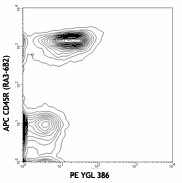
-

C57BL/6 splenocytes stained with APC CD45R (RA3-6B2) and PE rat IgG1, κ (RTK2071) isotype control (bottom) or PE YGL 386 (upper) -

C57BL/6 splenocytes stained with APC CD45R (RA3-6B2) and PE rat IgG1, κ (RTK2071) isotype control (bottom) or PE YGL 386 (upper)
| Cat # | Size | Price | Quantity Check Availability | Save | ||
|---|---|---|---|---|---|---|
| 120305 | 25 µg | $122 | ||||
| 120306 | 100 µg | $323 | ||||
GITR ligand (GITRL) is a member of the TNF superfamily, also known as TNFSF18 or TL6. It is expressed on B cells, macrophages, dendritic cells and endothelial cells. The expression of GITRL on dendritic cell surface can be transiently up-regulated and then rapidly down-regulated by LPS stimulation. GITRL binds to its receptor, GITR, to co-stimulate T cell activation, proliferation, and cytokine production, and inhibit the suppressive functions of CD4+CD25+ Treg cells, as well as induce macrophages activation. GITR-GITRL interaction has been implicated as an essential regulator of immune response to self antigens and phathogens.
Product DetailsProduct Details
- Verified Reactivity
- Mouse
- Antibody Type
- Monoclonal
- Host Species
- Rat
- Immunogen
- Recombinant mouse GITRL protein and Transfected cells
- Formulation
- Phosphate-buffered solution, pH 7.2, containing 0.09% sodium azide.
- Preparation
- The antibody was purified by affinity chromatography, and conjugated with PE under optimal conditions.
- Concentration
- 0.2 mg/ml
- Storage & Handling
- The antibody solution should be stored undiluted between 2°C and 8°C, and protected from prolonged exposure to light. Do not freeze.
- Application
-
FC - Quality tested
- Recommended Usage
-
Each lot of this antibody is quality control tested by immunofluorescent staining with flow cytometric analysis. For flow cytometric staining, the suggested use of this reagent is ≤ 1.0 µg per 106 cells in 100 µl volume. It is recommended that the reagent be titrated for optimal performance for each application.
- Excitation Laser
-
Blue Laser (488 nm)
Green Laser (532 nm)/Yellow-Green Laser (561 nm)
-
Application References
(PubMed link indicates BioLegend citation) -
- Tone M, et al. 2003. Proc. Natl. Acad. Sci. USA 100:15059
- Lu LF, et al. 2005. J. Immunol. 175:1651
- Esparza EM and RH Arch. 2005. J. Immunol. 174:7875
- Ray A, et al. 2012. J. Immunol. 188:3188. PubMed.
- Product Citations
-
- RRID
-
AB_2207248 (BioLegend Cat. No. 120305)
AB_2207248 (BioLegend Cat. No. 120306)
Antigen Details
- Structure
- TNF superfamily member
- Distribution
-
B cells, macrophages, dendritic cells, endothelial cells.
- Function
- Bind GITR receptor to co-stimulate T cells activation, proliferation, and cytokine production; inhibit the suppressive activities of CD4+CD25+ Treg cells.
- Ligand/Receptor
- GITR (TNFRSF18)
- Cell Type
- B cells, Macrophages, Dendritic cells, Endothelial cells, Tregs
- Biology Area
- Immunology
- Antigen References
-
1. Tone M, et al. 2003. Proc. Natl. Acad. Sci. USA 100:15059.
2. Kim JD, et al. 2003. Genes Immun. 4:564.
3. Yu KY, et al. 2003. Biochem. Biophys. Res. Commun. 310:433.
4. Shin HH, et al. 2002. Cytokine 19:187. - Gene ID
- 240873 View all products for this Gene ID
- UniProt
- View information about GITRL on UniProt.org
Related FAQs
- What type of PE do you use in your conjugates?
- We use R-PE in our conjugates.
Other Formats
View All GITR Ligand Reagents Request Custom Conjugation| Description | Clone | Applications |
|---|---|---|
| Purified anti-mouse GITR Ligand | YGL 386 | FC |
| PE anti-mouse GITR Ligand | YGL 386 | FC |
Customers Also Purchased
Compare Data Across All Formats
This data display is provided for general comparisons between formats.
Your actual data may vary due to variations in samples, target cells, instruments and their settings, staining conditions, and other factors.
If you need assistance with selecting the best format contact our expert technical support team.
-
Purified anti-mouse GITR Ligand
-
PE anti-mouse GITR Ligand

C57BL/6 splenocytes stained with APC CD45R (RA3-6B2) and PE ... 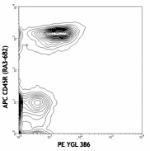
C57BL/6 splenocytes stained with APC CD45R (RA3-6B2) and PE ...

 Login/Register
Login/Register 










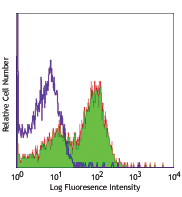
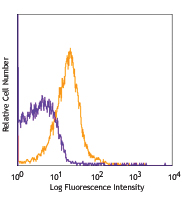
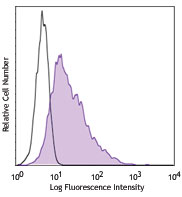



Follow Us